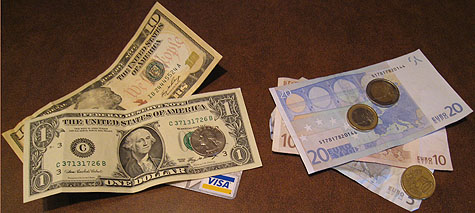
We just returned from a trip to Europe. We toured around France, in the areas of Provence in the south and Paris. We learned some important lessons about dealing with money overseas.
First, before you embark on your trip, make sure you tell your credit card company and bank when you are going. This way, when you use your ATM card or credit card overseas, they will know that the charges are authorized and not think that your card has been stolen. Otherwise, they might put a hold on your accounts!
While you’re on the phone with the bank and credit card company, ask them what their charges are for using the cards overseas and also what their current rate of exchange is. This way you’ll know how you’ll get your best rate. Most people will tell you that the best thing to do is to charge everything. This may not be the case for you. It wasn’t for us! Our credit card company charges us a 3% fee on all credit card purchases overseas (regardless of whether or not we pay our bill on time). Meanwhile, our bank charges us 1% of money withdrawn from ATM machines overseas.
It appears that most banks will only allow you to withdraw an equivalent amount of $500 US dollars per day. Also, you may be charged a fee for the ATM machine you’re using overseas.
Whatever the current exchange rate is that you read in the newspaper, you can expect to pay a little more.
We converted some money to euros before we left. Many people do this at the airport, but we were traveling with our young daughter, and lots of bags, so we didn’t want the added pressure of one more thing to worry about before or after the flight. My husband works in New York City, so it wasn’t too hard for him to find a place to make the conversion there, a few days before we left.
The rate of exchange we got was $1.62/euro (which was worse than the then current rate of $1.55/euro). Plus there was a flat fee $5.00.
That rate was better than what you’ll get in many cases at a currency exchange place in Europe. One that we found had an exchange rate of $1.77/euro if you’re exchanging less than $500 and $1.65/euro if you’re exchanging more than $500. Plus they had a surcharge of 6%. That’s a rate you’d want to avoid!
We were never able to find a bank in southern France that exchanged money. The truth is that we didn’t want to spend our whole days searching for one. Also, in southern France, many businesses close at lunchtime from 12 – 2 pm making the task more difficult.
Even in Paris we had a hard time finding a bank to exchange dollars into euros. Finally, once we ran out of the euros we had brought from the US we used our ATM card to withdraw more and in a pinch we used our credit card.
If you’re planning on traveling overseas in the future, I’d recommend exchanging some money before leaving on your trip. The rate might not be great, but it will most likely be better than or equal to what you’ll find overseas. Otherwise, depending upon your bank’s policy, you’ll need to decide which is the best course of action for you.
For further reading, here’s an article on the same subject by CNN called Choosing the Right Currency for Your Trip.
This article was posted on Tuesday, April 1st, 2008 at 3:12 pm and is filed under Exchanging Money Overseas, Foreign Currency, France, Mama Lisa, The Dollar versus the Euro, Traveling. You can follow any responses to this entry through the RSS 2.0 feed. You can skip to the end and leave a response. Pinging is currently not allowed.

























April 2nd, 2008 at 6:12 pm
It was quite a few years ago, but getting travelers checks from AAA in Swiss Francs worked out well for us on a vacation in Switzerland. On another trip, everywhere we shopped in Turkey, Ukraine, and Bulgaria was happy to accept U.S. dollars (although they only gave change in their own currency). It was, however, harder in Greece to pay with U.S. dollars.
Things have surely changed much since then.
April 2nd, 2008 at 6:33 pm
It’s my understanding that less places accept Travelers Checks than in the past. It used to be that we would mainly use them for money when traveling.
The dollar is very weak now. I believe there are still countries out there that accept it – like Jamaica, etc. Less places do know than in the past though.
You’re right – things have changed!
September 1st, 2008 at 1:10 pm
Just left Barcelona, Spain (1-9-08)…went to 4 banks before finding one that would cash Amex Travelers Checks. Happy to know it worked, I returned 4-days later to do same only to learn that they didn’t want to do it, something like they called and the numbers weren’t right. I don’t speak Spanish or Catalan and my young friend who does speak Spanish was equally bewildered by the problem since the Checks were from the same series as before. On my trip I had met the US Consulate General who didn’t know of an American Express office in Barca. I had been told about the 3% credit card fee mentioned in this blog so was reluctant to use mine. I also knew I’d get hosed on ATM fees. What to do? Eventually I found on a main drag, currency exchange kiosks. Against my better judgment I cashed some checks only to realize AFTER the transaction that my rate was $1.85/1E OUCH. Ask first! I think the best advice was given – get your Euros BEFORE you leave the US and do a good job of securing them on your person (I use a money belt and a wallet with a chain on it.
June 30th, 2009 at 3:24 pm
A friend told me about this, and I’m amazed it is so little known on the web so far… maybe it is new… I just bought Visa Travelmoney from AAA. It is a pre-loaded Visa card, that works just like a credit card (with a few exceptions). It cost $5 to buy. Unlike credit cards (all, I think) there is no 3% fee every time you charge something).
There IS a 3% fee plus ATM fees, however, to use an ATM for foreign cash, so not good for that purpose. It is only a good option for credit purchases, not for obtaining foreign currency.
For getting cash, my Bank acct’s Visa debit card does NOT charge the 3% fee (according to a phone call… I guess I’ll find out if I got accurate info after my trip!). It does charge a flat $2 fee each time I withdraw foreign currency, plus the foreign bank’s ATM will charge their fee. Still haven’t found a fee-free or cheaper way to get foreign currency!
January 22nd, 2010 at 7:47 am
There are “world” or “international” cards that do NOT charge the 3% fee. When I travel internationally I take both my Capital One and an American Express–neither have extra fees.
April 29th, 2012 at 1:09 pm
Soon I will be leaving for France where do you recommend a place in New York Long Island even in Manhattan to exchange money in Euro, please let me know as soon as possible…thank you
April 29th, 2012 at 5:38 pm
I believe you can order Euros at Chase Bank branches… just call first and ask which branches have Euros.